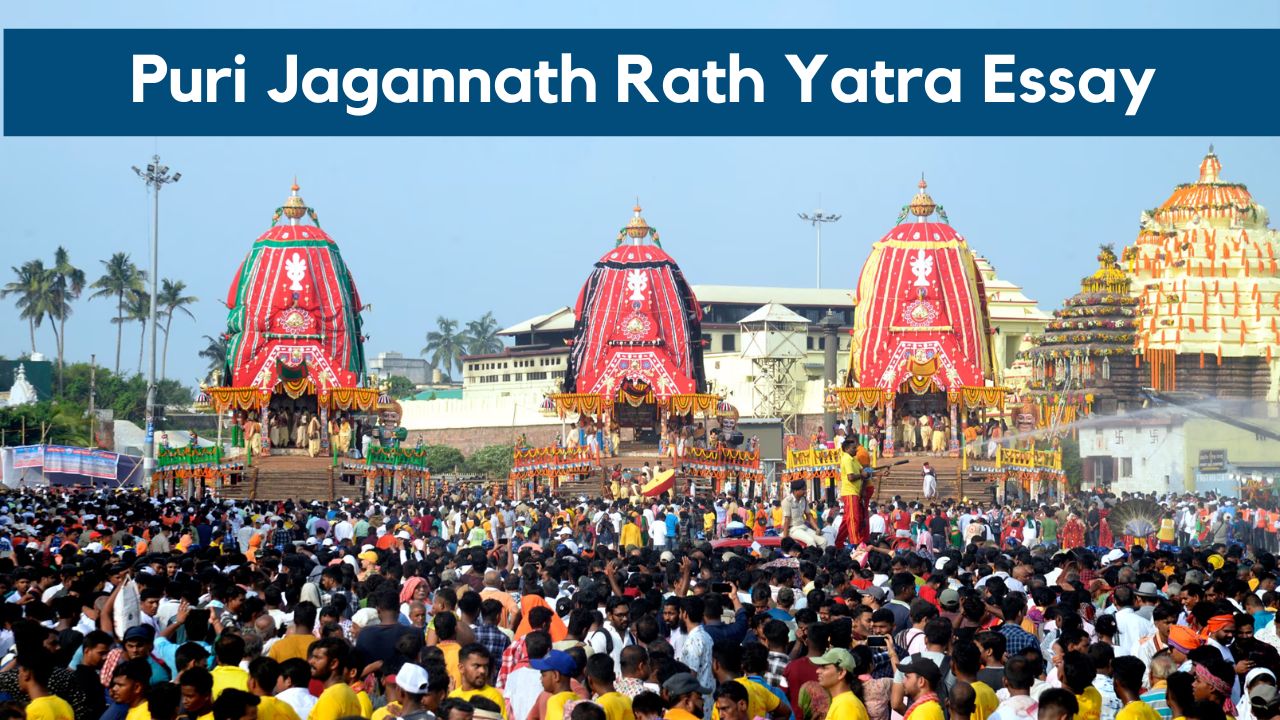Puri Jagannath Rath Yatra Essay
Puri Jagannath Rath Yatra Essay: The Puri Jagannath Rath Yatra, also known as the Chariot Festival, is a grand annual procession held in Puri, Odisha, India. Here are some key points about the Rath Yatra:
Historical Origins: The tradition of Rath Yatra has a long history that can be traced back several centuries. It has been a significant part of the cultural fabric of Odisha and holds deep-rooted religious and historical significance.
Significance: The Rath Yatra is one of the most important and widely celebrated festivals associated with the Puri Jagannath Temple. It commemorates the journey of Lord Jagannath, Lord Balabhadra, and Devi Subhadra from their temple to the Gundicha Temple.
Timing: The Rath Yatra takes place during the Hindu month of Ashadha (June/July) on the second day of the bright fortnight.
Chariots: Three massive wooden chariots are constructed every year for the deities to travel in. The chariots are named Nandighosa (for Lord Jagannath), Taladhwaja (for Lord Balabhadra), and Darpadalana (for Devi Subhadra).
Chariot Construction: The chariots are constructed anew every year using specified types of wood. Skilled artisans and carpenters from specialized families carry out the construction under strict guidelines.
Chariot Dimensions: The chariots are enormous and reach significant heights. The Nandighosa chariot is around 45 feet high and has 18 wheels, while the other two chariots are slightly smaller.
Decorations: The chariots are elaborately decorated with bright colors, intricate designs, and religious motifs. The decorations are done using a variety of materials, including cloth, flowers, and painted patterns.
Pulling the Chariots: Thousands of devotees gather in Puri to pull the chariots during the procession. Devotees consider it extremely auspicious to participate in pulling the chariots as it is believed to earn them divine blessings.
Ropes: Strong ropes made of thick jute fibers are used to pull the chariots. Devotees hold the ropes and enthusiastically pull the chariots through the streets of Puri.
Journey Route: The deities are taken from the Puri Jagannath Temple to the Gundicha Temple, located approximately 3 kilometers away. This symbolizes the deities’ visit to their aunt’s house.
Bahuda Yatra: After a week-long stay at the Gundicha Temple, the deities return to the Puri Jagannath Temple in a procession called the Bahuda Yatra. It follows a similar route but with some variations.
Chhera Pahanra: The Gajapati Maharaja, the king of Puri, performs a special ritual called Chhera Pahanra. He sweeps the chariots with a golden broom and offers prayers to the deities before the commencement of the Rath Yatra.
Devotee Enthusiasm: The Rath Yatra attracts millions of devotees from all over India and abroad. Devotees eagerly wait to catch a glimpse of the deities and seek their blessings.
Spiritual Significance: Participating in or witnessing the Rath Yatra is believed to cleanse one’s sins, bring good fortune, and deepen one’s devotion to Lord Jagannath.
Festive Atmosphere: The entire city of Puri comes alive during the Rath Yatra, with vibrant processions, music, dance performances, and various cultural activities.
Prasadam Distribution: Mahaprasad, the sacred food offered to the deities, is distributed to the devotees during the Rath Yatra. It is considered highly auspicious and is believed to grant spiritual benefits.
Security Measures: Due to the massive gathering of people, elaborate security arrangements are made by the authorities to ensure the safety of devotees and smooth conduct of the festival.
Global Recognition: The Rath Yatra of Puri Jagannath Temple is recognized worldwide for its grandeur, religious significance, and cultural heritage. It attracts tourists and devotees from various parts of the globe.
Rath Yatra Celebrations: The Rath Yatra is not limited to Puri alone. It is celebrated with great fervor in many other cities and countries where Jagannath devotees reside.
Symbol of Unity: The Rath Yatra serves as a unifying factor, bringing people from different backgrounds, castes, and communities together in devotion and celebration.




![National Youth Day [Vivekananda Jayanti ] - Student Essay](https://lyricsraaga.com/wp-content/uploads/2023/01/National-Youth-Day-Vivekananda-Jayanti-Student-Essay-200x125.png)